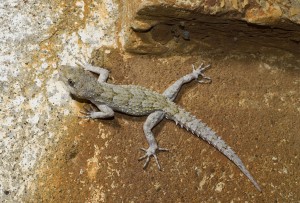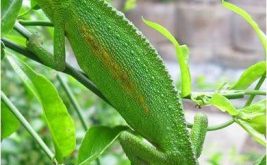
Name: Kotschy’s gecko
Scientific Name: Mediodactylus kotschyi
Kingdom: Animalia
Class: Squamata
Family: Gekkonidae
Genus: Cyrtopodion
Species: C. kotschyi
Description
The Kotschy’s gecko is a small lizard with a body that does not exceed 10cm along with the size of its tail. The pupil of his eyes is vertical, without eyelids and has a special feature: during the night it expands to facilitate his vision or when he has reduced visibility. Its body has a combination of gray with light brown color and on its back are located dark designs in the shape of “V”. The lower abdomen has a yellowish or orange color [1,2]. The dark color of his body, combined with his habit of remaining still, allows him to be almost invisible. This is also due to the fact that it has the ability to acquire darker or lighter tones of color, depending on the substrate in which it is located and the lighting conditions that prevail [5]. Also, a special feature of the half is that it has a thin body and thin edges, which have special formations that act as suction cups and help it to climb even on the smallest surfaces with great ease.
Habitat
The lizards of this species are found mainly in dry areas and bushes or in rocky areas, where they can find cover during the day. It is also often found in the ruins of houses, structures and walls. It is spread almost all over the island from the beach to the high peaks of Troodos. It is a nocturnal reptile, so it is easier for someone to encounter it at night, especially during the high temperatures of summer, but it is also found during the day, especially during the cold winter months when it has relatively low temperatures. When it feels threatened, it retreats and finds shelter in dense vegetation, in rocky areas and usually clings to the lower rock surface [2].
Food
Its food is mainly small arthropods, such as spiders and small insects.
Reproduction
As for reproduction, the female half hatch lays 1-2 eggs usually under stones and which hatch about a month after laying eggs. Their reproduction begins in the spring and can continue until autumn.
Sources:
[1] Πουλιά της Κύπρου, του Λουκά Χριστοφόρου, AFIAP, 1998
[2] http://www.katakali.net/drupal/?q=odika/aidoni
[3] www.platres.org
[4] http://www.exoticbirds.gr/index.php?option=com_content&view=article&id=97
[5] http://aksioperierga.blogspot.com/2013/01/blog-post_12.html
[6] http://www.birdlifecyprus.org/
Image source:
http://www.animalphotos.me/
 Κυπριακό Κέντρο Περιβαλλοντικής Έρευνας & Εκπαίδευσης – Κυκπεε
Κυπριακό Κέντρο Περιβαλλοντικής Έρευνας & Εκπαίδευσης – Κυκπεε



